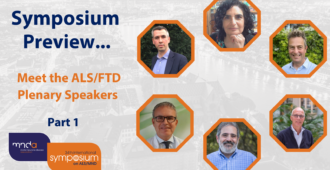Dr Andrea Malaspina is an Association-funded researcher investigating biomarkers, or ‘biological fingerprints’ of MND. Here he blogs about working with patients and basic science.
I regularly meet people living with MND due to my role as a Consultant Neurologist at the Bart’s and the London MND Care Centre and one of the most common questions I get asked is about getting involved in research. My research enables people living with MND to take part, therefore bridging the gap between the lab and the clinic.

Finding a biomarker
The work in both the lab, and in the clinic, to develop the ALS biomarkers study is something unique; it is almost testing how far creativity, persistence and chance can go together towards something good! The most remarkable part is seeing people with different backgrounds and expertise working together towards the same goal: a world free from MND.
First of all, what matters is the patient. All our efforts and hopes are towards finding some sort of ‘signal’ which would lead any person involved in the care of MND to recognise the disease and its early signs. We also want these signals to be representative of the progression of the disease – just like you need a reliable weather forecast, we want a reliable tool to predict progression!
The most important thing would be to be able to measure a biological signal (biomarker) that mirrors the disease. This way, if we are able to slow down or arrest the disease process, the expression of this molecule would change with the change in the disease state.
We would call this a biomarker of treatment response. It may not sound as interesting as other fancy research, but if you get this right, it means that you can develop more targeted clinical trials, where smaller numbers of patients can give you more information. Ultimately, less expensive clinical trials would lead to more drugs being tested and, hopefully, to the right treatment!
 The problems with measuring proteins
The problems with measuring proteins
The holy-grail is a sample which is collected following very strict procedures and processed as soon as possible. What we want to obtain and preserve are very precious proteins, which will be measured with sensitive methods and therefore, any delay in the handling of the biological specimen can have an unexpected effect or even, change irreversibly what you may want to measure.
This is why we need to process blood and urine samples quickly.
You may be surprised to know how difficult it is to measure something that comes from the human body, such as proteins.
When proteins are released in biological fluids they change the microenvironment around them (eg proteins that make up the structure of neurons break down in MND). These proteins may end up assembling among themselves, or with other proteins, forming aggregates (or clumps), making them almost invisible to any attempt to measure them.
These proteins may also awaken the immune system, which is normally quite tolerant to any protein that belongs to the same biological entity it is trying to protect! Antibodies produced from the immune system can clear the proteins we are trying to test, making it difficult to make any sense of the data obtained by these investigations!
The ALS biomarker study
The unique part of this study is the team involved. You will see neurologists talking with scientists and research nurses talking to phlebotomists and laboratory technicians. All working together, possibly even sharing the same physical space!
I am currently recruiting people living with MND to take part in this study. There are no strict eligibility criteria; however participants would need to travel to the Barts and the London MND Care Centre on a regular basis to donate blood and urine samples. Find out more about this study on the MND Association’s website, as well as contact details if you wish to take part.
The bottom line is that there is no easy answer to the problem of finding something you can access with a blood test, which would inform about the onset and the development of the disease.
There are too many variables, too much noise! But the right signal is hidden somewhere, and we will eventually manage to find it for the benefit of science and above all, of people living with MND.






Hi I have MND would love to help but I live in Australia ‘
Hi Alexa,
It’s great that you are interested in getting involved in MND research and it may be worth contacting MND Australia, who would be able to let you know about any research opportunities in your area. Their contact details are available via their website: http://www.mndaust.asn.au/Home.aspx
Kind regards,
Samantha Price, PhD
Research Information Co-ordinator, MND Association, UK
The ALS biomarkers study: a journey into the disease | MND Research